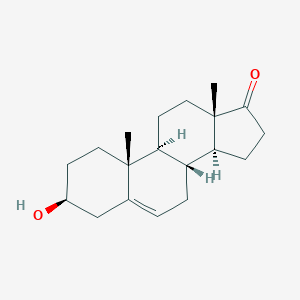| General Information of MET (ID: META00150) |
| Name |
Dehydroepiandrosterone
|
| Synonyms |
Click to Show/Hide Synonyms of This Metabolite
(+)-Dehydroisoandrosterone; (3-beta)-3-Hydroxyandrost-5-en-17-one; (3beta)-3-Hydroxy-androst-5-en-17-one; (3beta,16alpha)-3,16-Dihydroxy-androst-5-en-17-one; 17-Chetovis; 17-Hormoforin; 3-BETA-HYDROXY-5-androsten-17-one; 3-beta-Hydroxyandrost-5-en-17-one; 3b-Hydroxy-D5-androsten-17-one; 3beta-Hydroxy-5-androsten-17-one; 3beta-Hydroxy-D5-androsten-17-one; 3beta-Hydroxy-androst-5-en-17-one; 3beta-Hydroxyandrost-5-en-17-one; 5 Androsten 3 beta hydroxy 17 one; 5 Androsten 3 ol 17 one; 5,6-Dehydroisoandrosterone; 5,6-Didehydroisoandrosterone; 5-Androsten-3-beta-hydroxy-17-one; 5-Androsten-3-beta-ol-17-one; 5-Androsten-3-ol-17-one; 5-Androsten-3b-ol-17-one; 5-Androsten-3beta-ol-17-one; 5-Dehydro-epiandrosterone; 5-Dehydroepiandrosterone; Andrestenol; Androst-5-ene-3b-ol-17-one; Androst-5-ene-3beta-ol-17-one; Androsten-3beta-ol-17-one; Androstenolone; Astenile; Biolaif; D5-Androsten-3b-ol-17-one; D5-Androsten-3beta-ol-17-one; DHA; DHEA; Deandros; Dehydro-epi-androsterone; Dehydroisoandrosterone; Diandron; Diandrone; EM-760Dehydroandrosterone; Hydroxyandrostenone; Intrarosa; Prasterona; Prasterone; Prasterone, 3 alpha isomer; Prasterone, 3 alpha-isomer; Prasteronum; Prestara; Psicosterone; trans-Dehydroandrosterone
|
| Source |
Endogenous;Sterol lipids;Food;Carcinogenic Potency;Cosmetic
|
| Structure Type |
Androstane steroids (Click to Show/Hide the Complete Structure Type Hierarchy)
Lipids and lipid-like molecules
Steroids and steroid derivatives
Androstane steroids
|
| PubChem CID |
|
| HMDB ID |
|
| Formula |
C19H28O2
|
| Structure |
<iframe style="width: 300px; height: 300px;" frameborder="0" src="https://embed.molview.org/v1/?mode=balls&cid=5881"></iframe>
|
 |
|
3D MOL
|
2D MOL
|
|
Click to Show/Hide the Molecular/Functional Data (External Links/Property/Function) of This Metabolite
|
| KEGG ID |
|
| DrugBank ID |
|
| ChEBI ID |
|
| FooDB ID |
|
| ChemSpider ID |
|
| METLIN ID |
|
| Physicochemical Properties |
Molecular Weight |
288.4 |
Topological Polar Surface Area |
37.3 |
| XlogP |
3.2 |
Complexity |
508 |
| Heavy Atom Count |
21 |
Rotatable Bond Count |
N.A. |
| Hydrogen Bond Donor Count |
1 |
Hydrogen Bond Acceptor Count |
2 |
| Function |
Dehydroepiandrosterone (DHEA) is a natural steroid hormone produced from cholesterol by the adrenal glands. DHEA is also produced in the gonads, adipose tissue, and the brain. DHEA is structurally similar to and is a precursor of, androstenedione, testosterone, estradiol, estrone, and estrogen. It is the most abundant hormone in the human body. Most of DHEA is sulfated (dehydroepiandrosterone sulfate or DHEA-S) before secretion. DHEA-S is the sulfated version of DHEA; this conversion is reversibly catalyzed by sulfotransferase (SULT2A1) primarily in the adrenals, the liver, and small intestines. In blood, most DHEA is found as DHEA-S with levels that are about 300 times higher than free DHEA. Blood measurements of DHEA-S/DHEA are useful to detect excess adrenal activity as seen in adrenal cancer or hyperplasia, including certain forms of congenital adrenal hyperplasia. Women with polycystic ovary syndrome tend to have normal or mildly elevated levels of DHEA-S.
|
|
Regulatory Network
|
|
|
|
|
|
|
|
|
 click to show the details of this protein
click to show the details of this protein
 click to show the details of experiment for validating this pair
click to show the details of experiment for validating this pair
 click to show the details of this protein
click to show the details of this protein
 click to show the details of experiment for validating this pair
click to show the details of experiment for validating this pair
 click to show the details of experiment for validating this pair
click to show the details of experiment for validating this pair

